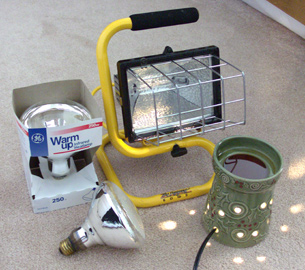Will incandescent lights die?
February 20, 2010
Archive
Archive
There’s been a lot of advancement in the field of lighting, particularly solid state lighting with LEDs, but that doesn’t necessarily mean incandescent bulbs will phase out. Consider that they were probably conceived as a way to replace candles, and they excel at that, (heat and light). Also, candles haven’t phased out.
 It’s been said that only 5% of the energy going into incandescent light bulbs results in light. 95% of that energy results in heat. I see no reason to refute this, they get hot! Now that’s efficient… for heat production.
It’s been said that only 5% of the energy going into incandescent light bulbs results in light. 95% of that energy results in heat. I see no reason to refute this, they get hot! Now that’s efficient… for heat production.
Other places where people would prefer incandescent bulbs over the newer bulbs would be in cold locations or climates. If you move from Texas to a northern state, you’d probably prefer more heat. If you’re working outside on a cold winter day, those hot halogen work lights feel pretty good.
Then there’s the burning question of “who is the government to dictate what bulbs I can’t use?” I find it particularly disturbing that the government would do this (among many other things). But, I look forward to LEDs being used in lighting applications, because you get more light per watt of energy.
Today’s Applications
Incandescent lights still have a place in the modern world, but not necessarily as a lighting source. They produce light, but most of all, they produce heat. Here are some modern day applications:- Heat Lamps (more examples here and here)
- Reptile Heating and Lighting (more examples here and here)
- Incubation (more examples here and here)
- Easy Bake Oven
- Scentsy (a flameless scented candle)
- Plant Grow Lights
Give Me Heat!
 It’s been said that only 5% of the energy going into incandescent light bulbs results in light. 95% of that energy results in heat. I see no reason to refute this, they get hot! Now that’s efficient… for heat production.
It’s been said that only 5% of the energy going into incandescent light bulbs results in light. 95% of that energy results in heat. I see no reason to refute this, they get hot! Now that’s efficient… for heat production.Other places where people would prefer incandescent bulbs over the newer bulbs would be in cold locations or climates. If you move from Texas to a northern state, you’d probably prefer more heat. If you’re working outside on a cold winter day, those hot halogen work lights feel pretty good.
What about the Energy Independence and Security Act of 2007?
Some might be concerned about the federal bill that phases out incandescent light bulbs between 40 and 150 watts. (See Subtitle B, Sec. 321 in the full text.) However, there seems to be enough exceptions that a simple relabeling could probably circumvent such restrictions. Just because “incandescent light bulbs” may not be sold doesn’t mean “heat bulbs” can’t be sold.Then there’s the burning question of “who is the government to dictate what bulbs I can’t use?” I find it particularly disturbing that the government would do this (among many other things). But, I look forward to LEDs being used in lighting applications, because you get more light per watt of energy.






